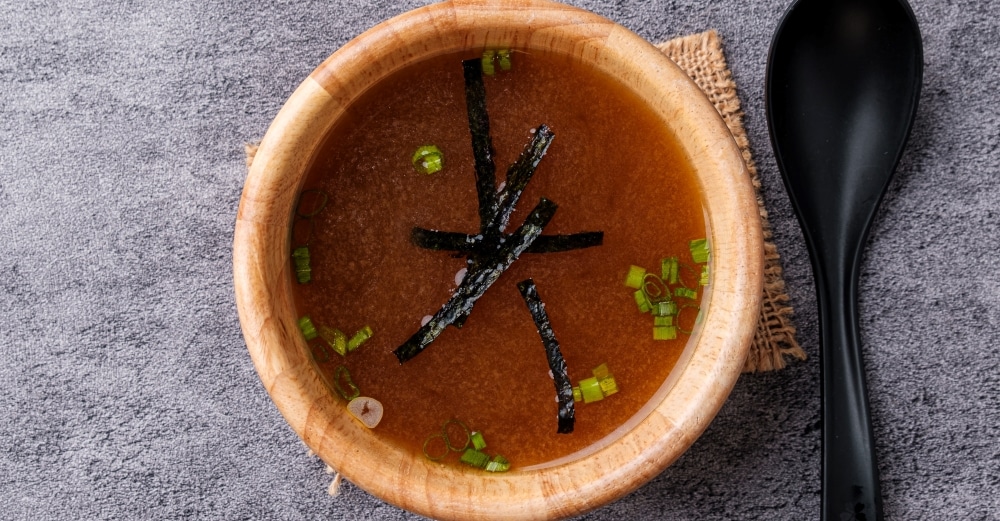Growing Trends in Food: A taste of the Umami
Known as the fifth flavor profile, umami is the moreish and mysterious taste originating from Asia that Western consumers just can’t get enough of. Back in 2020, the global umami market was valued at around 0.9 billion US dollars, but now it’s estimated to reach 1.15 billion by 2028 – a 6.70% CAGR projection 1 .
The growth of umami over the last three years has been noted by those in the food industry, and many are trialling this flavor profile as part of interesting combinations – such as in cocktails and desserts, with the popular miso caramel flavoring delivering the perfect sweet, savory and umami combination.
What is umami?
The Japanese Chemist Kikunae Ikeda first identified and coined the term ‘umami’ in 1908 as part of an experiment to understand what gave his wife’s soups their unique flavor 2 . What Ikeda discovered was that umami is made up of the amino acid monosodium glutamate, a building block of protein, which gives it the well-known savory, meaty and broth-like taste.
There are plenty of Asian dishes that are known for their umami flavouring. Ingredients like shiitake mushrooms, seaweed or kelp, wasabi and fermented products like soy sauce and miso are packed with glutamate and are often used in stir-fry dishes to deliver that rich savory flavour. Miso, made from fermented soybeans for example, delivers 100mg of glutamate per 100g, while the kombu (dried kelp) variety of seaweed features up to 3,000mg of glutamate per 100g 3 .
Why is umami so popular?
Exotic flavor profiles have grown in popularity with consumers following the Covid-19 pandemic. When ‘foodies’ couldn’t travel, they brought the experience home to their dining table, often experimenting with flavours, botanicals and herbs from Asia such as calamansi, yuzu, and kumquat 4 or citrus flavors originating from the Mediterranean like blood orange. A mix of sweet and salty flavor profiles became popular with consumers who switched to a plant-based diet for health or environmental reasons. Umami-enriched seasonings were used as toppings on plant-based meats, since it only served to enhance the ‘meaty’ taste.
While in Europe, Asian food has been on the uptick since the 2010s with consumers, the US has only recently become heavily influenced by the complex taste and texture profiles from Japan, India and Korea. Social media research carried out in 2023 reported that eight out of ten of the most popular cuisines were from Asian cultures based on Instagram hashtags 5 . A cultural shift is happening in the US – and heritage is at the source.
Umami isn’t just a flavor profile of Asian foods though, it can be found in a variety of meats, fish and shellfish. For example, using the smoking process for fish not only helps to preserve it, but can also extract the ‘umami’ taste and the rich, savory aroma that evokes the senses. Smoked salmon with a miso or honey-soy glaze is the perfect combination due to its delicate balance of sweet, savory and salty taste.
Umami in functional foods
Food scientists have also been exploring other ways umami helps to benefit us for some time now. Back in 2015, a study from the University of Southern Denmark published in the open access journal Flavour, discovered that kokumi substances could improve the taste of low-fat foods 6 . A study published in 2018 from Beth Israel Deaconess Medical Center also noted that consuming a broth that’s rich in umami can change signals in the brain to promote healthy eating behaviors 7 . While in 2021, researchers studied the effects when pairing high glutamate beverages with foods high in ribonucleotides (such as an aged wine with scallops) – the result was a synergistic flavor profile that enhanced the umami experience 8 .
This makes umami-rich foods a strong contender for better-for-you foods. Food manufacturers looking to reduce salt, for instance, could use salt replacers like potassium chloride in combination with umami substances to achieve the desired taste profile. Low-calorie or low-fat soups can also be enhanced with umami substances too, such as when we combine miso flavorings with nutrient-dense salmon.
Enhance umami with SalMe Peptides S
That’s why biomega ® SalMe Peptides are perfect for creating the umami experience in functional foods. Our patented process, which uses continuous enzymatic hydrolysis to gently separate the nutrients from rest-raw materials, produces salmon peptides that are not only 100% water soluble, but are also easy to digest for the consumer and easily added into the manufacturing process. SalMe Peptides S are high in protein, taurine and collagen content to offer the best in vitality to consumers.
Brands can use SalMe Peptides S in a variety of health food formulations. Miso soup, for example, makes for an intense flavor formulation and can be developed as part of a low-fat range of better-for-you products. It can even be used as a seasoning in stir-fry dishes as opposed to a heavily processed sauce. It just goes to show that a taste of the umami is never too far out of reach!
Speak to our team today to find out how you can use our SalMe Peptides S to develop a sensory experience for your customers today by contacting us here !
References:
1. Data Bridge Market Research, April 2021. https://www.databridgemarketresearch.com/reports/global-umami-flavours-market
2.3. Readers Digest, 13 foods with natural umami, August 2023
5. NBC News, How kids of immigrants made Asian food most popular cuisines on social media, May 2023
6. Ole G Mouritsen, The science of taste, Flavour, 2015; 4 (1): 18 DOI: 10.1186/s13411-014-0028-3.
